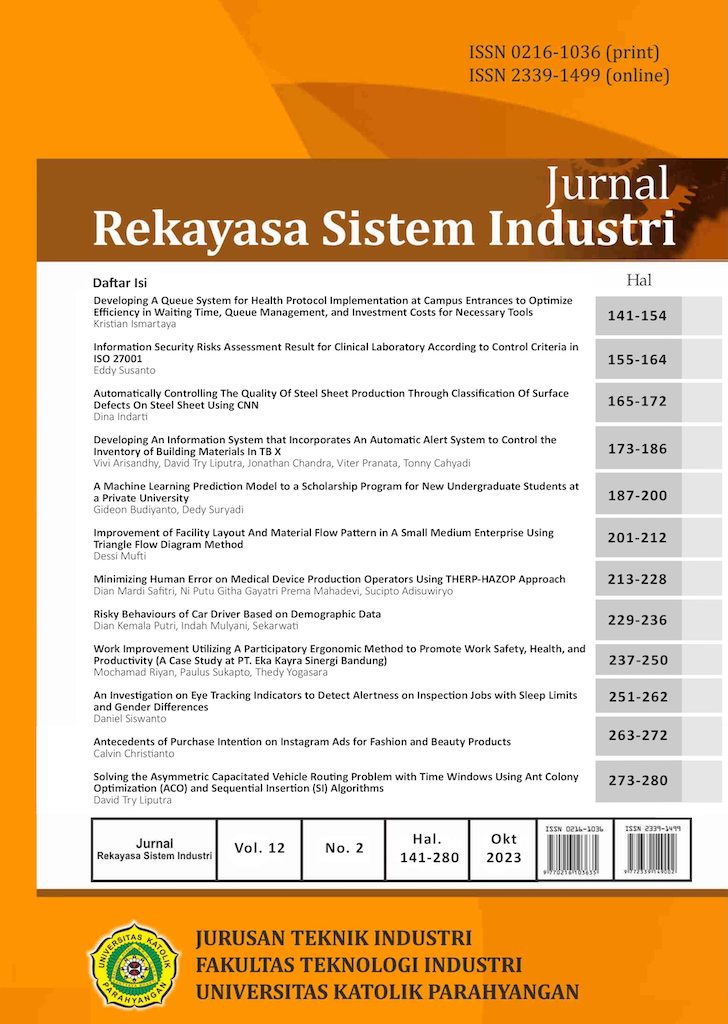Automatically Controlling The Quality Of Steel Sheet Production Through Classification Of Surface Defects On Steel Sheet Using CNN
DOI:
https://doi.org/10.26593/jrsi.v12i2.5862.165-172Keywords:
classification, convolutional neural network, quality control, steel sheet, surface defectsAbstract
Quality control of steel sheet production using human visual perception frequently results in errors and takes longer. The implementation of deep learning to control the quality of steel sheet production can be done with high accuracy and in real time. The classification of surface defects on steel sheet is critical for automatically controlling the quality of steel sheet production. Deep learning can quickly identify and eliminate the causes of defects in sheet steel production by classifying the type of defects. This study aims to control the quality of steel sheet production automatically by classifying the types of surface defects using the Convolutional Neural Network (CNN). The CNN model used in this study is CNN with transfer learning from 5 pre-trained models Resnet50, VGG-16, VGG-19, Inception V3, and Xception. There are 6 types of surface defects, namely crazing, inclusion, pitted, patches, rolled, and scratch. The research begins with taking image data on steel sheet that has surface defects. The number of images used in this study is 1.800 images consisting of 1.152 training data, 288 validation data, and 360 testing data. Preprocessing is carried out, namely normalization, augmentation, and one-hot encoding. After preprocessing, training and validation was carried out using transfer learning from 5 pre-trained models. The training result model is used at the testing stage. The results of the training and validation show that Xception has the best performance because of the highest training and validation accuracy values, the lowest training and validation losses, and the lowest validation and loss GAPs. The test results show that transfer learning from the pre-trained Xception model has the best performance with an accuracy of 98%.
References
Bansal, A. (2020). Identification and Classification of Defects in Steel Sheets using Deep Learning Models [National College of Ireland]. http://norma.ncirl.ie/4432/1/akanshabansal.pdf
Bissi, L., Baruffa, G., Placidi, P., Ricci, E., Scorzoni, A., & Valigi, P. (2013). Automated defect detection in uniform and structured fabrics using Gabor filters and PCA. Journal of Visual Communication and Image Representation, 24(7), 838–845. https://doi.org/10.1016/j.jvcir.2013.05.011
Chollet, F. (2017). Xception: Deep Learning with Depthwise Separable Convolutions. 2017 IEEE Conference on Computer Vision and Pattern Recognition (CVPR), 1800–1807. https://doi.org/10.1109/CVPR.2017.195
Han, J., Kamber, M., & Pei, J. (2011). Data Mining Concepts and Techniques (3rd ed.). Elsevier.
He, K., Zhang, X., Ren, S., & Sun, J. (2016). Deep Residual Learning for Image Recognition. 2016 IEEE Conference on Computer Vision and Pattern Recognition (CVPR), 770–778. https://doi.org/10.1109/CVPR.2016.90
Kaggle. (2020). Metal Surface Defects Dataset. https://www.kaggle.com/fantacher/neu-metal-surface-defects-data
Kingma, D. P., & Ba, J. (2014). Adam: A Method for Stochastic Optimization. http://arxiv.org/abs/1412.6980
Konovalenko, I., Maruschak, P., Brezinová, J., Viňáš, J., & Brezina, J. (2020). Steel surface defect classification using deep residual neural network. Metals, 10(6), 1–15. https://doi.org/10.3390/met10060846
Krizhevsky, A., Sutskever, I., & Hinton, G. E. (2017). ImageNet classification with deep convolutional neural networks. Communications of the ACM, 60(6), 84–90. https://doi.org/10.1145/3065386
Luo, Q., Fang, X., Liu, L., Yang, C., & Sun, Y. (2020). Automated Visual Defect Detection for Flat Steel Surface: A Survey. IEEE Transactions on Instrumentation and Measurement, 69(3), 626–644. https://doi.org/10.1109/TIM.2019.2963555
Mazur, I., & Koinov, T. (2016). Quality Control system for a hot-rolled metal surface. Frattura Ed Integrità Strutturale, 10(37), 287–296. https://doi.org/10.3221/IGF-ESIS.37.38
Montgomery, D. C. (2009). Introduction to Statistical Quality Control (6th ed.). John Wiley & Son.
Qayyum, R., Kamal, K., Zafar, T., & Mathavan, S. (2016). Wood Defects Classification Using GLCM Based Features And PSO Trained Neural Network. 22nd International Conference on Automation and Computing (ICAC), 273–277. https://doi.org/https://doi.org/10.1109/IConAC.2016.7604931
Russell, S., & Norvig, P. (2021). Artificial Intelligence A Modern Approach. Pearson.
Sharifzadeh, M., Alirezaee, S., Amirfattahi, R., & Sadri, S. (2008). Detection of steel defect using the image processing algorithms. 2008 IEEE International Multitopic Conference, 125–127. https://doi.org/10.1109/INMIC.2008.4777721
Simonyan, K., & Zisserman, A. (2014). Very Deep Convolutional Networks for Large-Scale Image Recognition. http://arxiv.org/abs/1409.1556
Szegedy, C., Vanhoucke, V., Ioffe, S., Shlens, J., & Wojna, Z. (2016). Rethinking the Inception Architecture for Computer Vision. 2016 IEEE Conference on Computer Vision and Pattern
Recognition (CVPR), 2818–2826. https://doi.org/10.1109/CVPR.2016.308
Tammina, S. (2019). Transfer learning using VGG-16 with Deep Convolutional Neural Network for Classifying Images. International Journal of Scientific and Research Publications (IJSRP), 9(10), 143–150. https://doi.org/10.29322/IJSRP.9.10.2019.p9420
Torrey, L., & Shavlik, J. (2010). Transfer Learning. In Handbook of Research on Machine Learning Applications and Trends: Algorithms, Methods, and Techniques (pp. 242–264). IGI Global.
Vergara-Villegas, O. O., Cruz-Sánchez, V. G., de Jesús Ochoa-Domínguez, H., de Jesús Nandayapa-
Alfaro, M., & Flores-Abad, Á. (2014). Automatic Product Quality Inspection Using Computer Vision
Systems. In Lean Manufacturing in the Developing World (pp. 135–156). Springer International Publishing. https://doi.org/10.1007/978-3-319-04951-9_7
Zhang, C., Sargent, I., Pan, X., Gardiner, A., Hare, J., & Atkinson, P. M. (2018). VPRS-Based Regional Decision Fusion of CNN and MRF Classifications for Very Fine Resolution Remotely Sensed Images. IEEE Transactions on Geoscience and Remote Sensing, 56(8), 4507–4521. https://doi.org/10.1109/TGRS.2018.2822783
Zhou, S., Chen, Y., Zhang, D., Xie, J., & Zhou, Y. (2017). Classification of surface defects on steel sheet using convolutional neural networks. Materiali in Tehnologije, 51(1), 123–131. https://doi.org/10.17222/mit.2015.335

